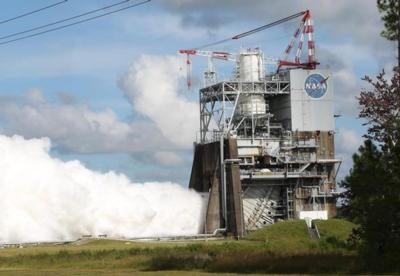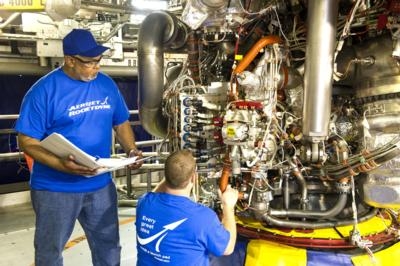Fri, Aug 11, 2017
EM-1 Planned For 2019
The fourth RS-25 engine controller needed for the inaugural flight of NASA’s Space Launch System (SLS) during Exploration Mission-1 (EM-1) was tested recently by Aerojet Rocketdyne at NASA’s Stennis Space Center.

“The SLS rocket will enable missions no other current rocket can, such as landing humans on Mars and sending large science payloads to other planets in record time,” said Aerojet Rocketdyne CEO and President Eileen Drake. “This is the rocket the nation will rely on for decades.”
Four RS-25 main engines built by Aerojet Rocketdyne provide more than two million pounds of thrust for the first stage of the SLS rocket. These are the world’s most reliable rocket engines with 14 of 16 assigned to the SLS program having previously flown on the Space Shuttle. NASA and Aerojet Rocketdyne are testing the RS-25 engines to confirm they can withstand the SLS flight environment as well as certifying the new engine controllers.
New engine controllers are a central technology upgrade that these engines are receiving. These controllers weigh less, use less power and have fewer parts, but are more robust than their shuttle era counterparts and provide two times the reliability. The flight controller is the “brain” of the engine, translating the vehicle’s commands into action while monitoring the health of the engine.

“The upgraded RS-25 engines are just one example of how the country is preparing a new course for deep space exploration,” said Dan Adamski, RS-25 program director at Aerojet Rocketdyne. “EM-1 is the first step in a new roadmap to explore the solar system.”
EM-1 is the first launch of the SLS and upgraded RS-25 engines; it is also the first integrated test of SLS and the Orion spacecraft. During the three-week mission, the Orion spacecraft will travel in a distant retrograde orbit around the moon and return safely back to Earth.
(Source: Aerojet Rocketdyne news release. Images from file)
More News
Also: Netherlands Donates 18 F16s, 2 737s Collide On Ramp, E-7 Wedgetail Cut, AgEagle's 100th In S Korea The Pilot and Aircraft Privacy Act was introduced in the House by Represent>[...]
Pilot Also Reported That Due To A Fuel Leak, The Auxiliary Fuel Tanks Were Not Used On June 4, 2025, at 13:41 eastern daylight time, a Piper PA-23, N2109P, was substantially damage>[...]
Have A Story That NEEDS To Be Featured On Aero-News? Here’s How To Submit A Story To Our Team Some of the greatest new stories ANN has ever covered have been submitted by our>[...]
From 2023 (YouTube Edition): Reflections on War’s Collective Lessons and Cyclical Nature The exigencies of war ought be colorblind. Inane social-constructs the likes of racis>[...]
What Goes Around, May Yet Come Back Around, Klyde FMI: www.klydemorris.com>[...]
 Airborne 06.30.25: US v ADS-B Misuse, Natl STOL Fire, Volocopter Resumes
Airborne 06.30.25: US v ADS-B Misuse, Natl STOL Fire, Volocopter Resumes NTSB Prelim: Piper PA-23
NTSB Prelim: Piper PA-23 ANN FAQ: Submit a News Story!
ANN FAQ: Submit a News Story! Classic Aero-TV: One Mans Vietnam
Classic Aero-TV: One Mans Vietnam Klyde Morris (06.30.25)
Klyde Morris (06.30.25)




